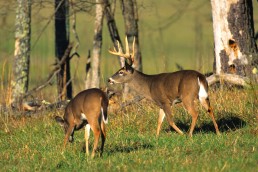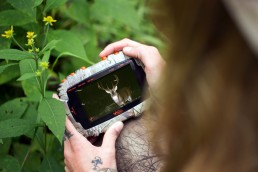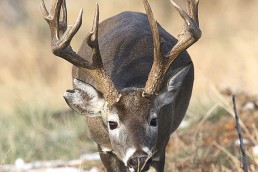The Perfect Enticement for Early-season Bucks
SHARE THIS POST
In a whitetail’s world, early season is all about being communal with other deer. Knowing the social structure of the herd is a key to getting scent, calls, decoys or other stimuli meant for drawing a positive response, to work for a hunter. Many feel they shouldn’t use certain tactics until just before the rut, however, early in the season can be the easiest time to draw a comeback.
During late summer and early fall whitetails can be very social, but primarily within their own sex. You may see them feeding side by side in a food plot, but for the most part, bucks are sociable with other bucks, while does and fawns are sociable with other does and fawns. Testosterone will change things very soon, but early, this is the case.
Can you smell it?
It now makes sense to use buck “smells,” “vocalizations” or “buck decoys” to draw a response from other bucks, while using doe or fawn “stimuli” to attract the does or fawns. But when it comes to mature bucks, they may or may not be social with the other bucks. Sometimes older bucks can become isolated and don’t need the communal contact like the younger deer do.
During September, increased amounts of testosterone flow through a buck’s body and he is ready to breed. The farther south you go, the later this seems to happen. It can also be spread out over a longer period, so in the South there is more of a margin for error.
Contrary to some beliefs, it’s the does that dictate when breeding will actually take place. The bucks will remain social with the other bucks until the does exhibit the first signs of coming into estrus.
When it comes to choosing a scent, it’s not the best idea to begin with an estrus lure. When it comes to deer smells you want to use ones that occur “naturally” in the wild. This obviously is applicable only to deer smells, scents that actually come from deer, like urine, glandular lures or musk-type smells. This is not the case for “curiosity” smells or food lures.
I’ve had estrus lures work well on mature bucks early in the season, and if you are specifically after a mature one, it may be a tactic you wish to try first. But for most early-season opportunities you are probably better off with plain urine or a curiosity scent, like Trail’s End #307.
There are many ways to dispense scent during this period, but two of my favorite tools are a Pro-Drag and Magnum Scrape Dripper. The Pro-Drag creates a scent trail and is easy to control. I’ve also used Select Doe Urine, Golden Buck and Mega Tarsal Plus.
When testosterone rears its head, mock scrapes can be an effective tactic. Sometimes using mock scrapes too early in the year can be intimidating to young bucks, but may be “just the ticket” for the breeding-class bucks. Mature bucks will feel an urge to claim, mark and defend breeding territory earlier in the season than the younger bucks.
Are you enjoying this post?
You can be among the first to get the latest info on where to go, what to use and how to use it!
The Magnum Scrape Drippers for mock scrapes are great for dispensing any type of liquid scent, and not just those associated with the mock scrapes. This device is heat-activated and will drip only during daytime hours, conditioning deer to show up during the legal hunting hours. It doesn’t have to be used only at mock scrapes, as it works great at dispensing all kinds of scent like food lures or curiosity scents.
Around the opener and the following couple of weeks, a trail of Trail’s End #307 can be “killer.” This lure is effective because it appeals not only to a whitetail’s curiosity, but also to their sense of hunger and desire to repopulate.
Can you hear it?
Calling bucks during the early season can be easy, but you don’t want to throw a rut-time repertoire at them. Soft, social buck sounds will work best. When it comes to mature bucks, as I said earlier, their urge to claim, mark and defend territory occurs earlier in the year with them than with the younger bucks so sometimes lower-toned, social grunts or even rattling works. When I say rattling, I’m not talking about imitating a knockdown, drag-out fight like you might during late October or November. I mean just “tickle” the antlers together to imitate sparring. You’re not fighting; you’re two brothers in a friendly arm-wrestling contest. They’ll respond, wanting to be social with others and testing communal structure, not to confront an intruder.
Can you see it?
Using decoys early is a tactic many don’t fully understand. For the most part, I feel a buck decoy with small antlers will give you the most positive outcomes with the bucks. To present certain scenarios to specific deer, I may want large antlers or a specific posture with the decoy. However, most situations a small buck decoy in an unintimidating posture will work.
With decoys, movement is significant. So when is it natural for a standing deer to be totally motionless?
When something is wrong.
Attaching a chicken feather, white hanky or even the real tail of a whitetail to a decoy setup can be successful. You don’t need much movement. When the buck looks at your decoy, just a twitch seems to sell the con. I tie on a small, 8-inch square section of a white hanky or other white cloth to a short string. I’ll tape the other end of the string to the decoy’s hind-end. The smallest breeze will give your fake tail movement.
Sensory profusion
The more senses we satisfy the more the situation seems real, and it’s no different with whitetails. Using these motivations in conjunction with one another is when I’ve had the most results. The buck sees your buck decoy so he drops downwind to scent-check the subject, but you’ve placed out some Golden Buck to appease one of his other senses. He sees or smells another buck so you throw a social buck grunt at him—you can see where I’m going.
Early season is about bucks being social with other bucks and testing their societal formation. You must give them a reason to close the distance to you. Use buck stimuli to bring the bucks closer, and use doe or fawn motivations to bring does and fawns closer.
MWO
SHARE THIS POST
Did you enjoy this post?
You can be among the first to get the latest info on where to go, what to use and how to use it!



